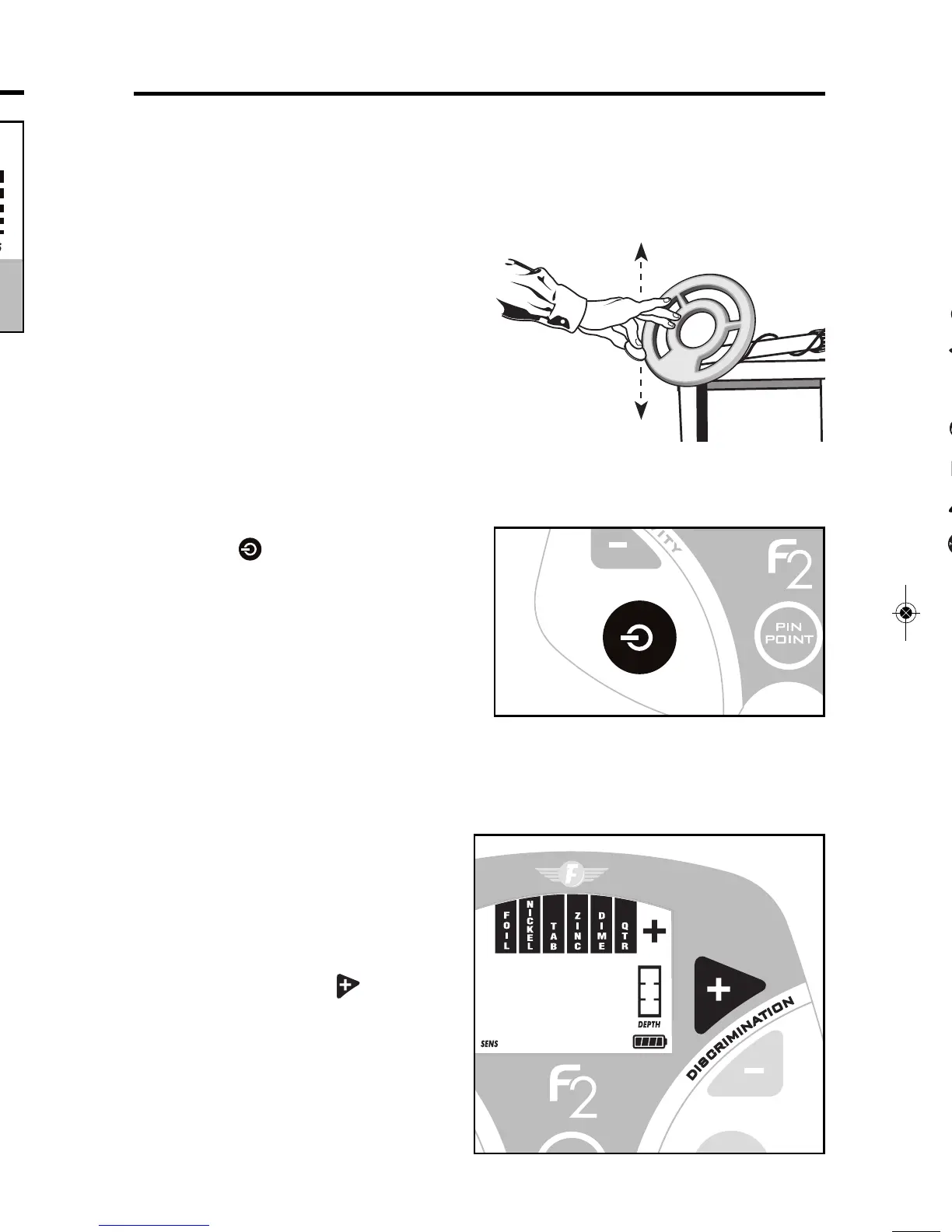QUICK-START DEMONSTRATION
I. Supplies Needed
• A Nail • A Quarter
• A Zinc Penny (dated after 1982) • A Nickel
II. Position the Detector
a. Place the detector on a table,
with the searchcoil hanging
over the edge. (or better, have
a friend hold the detector, with
the coil off the ground).
b. Keep the searchcoil away from
walls, floors, and metal objects.
c. Remove watches, rings and
other jewelry or metal objects
from hands and wrists.
d. Turn off appliances or lights that cause electromagnetic interference.
e. Pivot the searchcoil back toward the detector body.
III. Power Up
Press .
NOTE:
Immediately after powering
on, your detector's unique 10-digit
serial number is displayed once on
the LCD. Two digits are displayed at
a time; five 2-digit numbers are
displayed in sequence. This 10-digit
serial number is the same serial
number imprinted on the label inside the battery compartment.
IV. Wave each Object over the Search Coil
a.Notice a different tone for each object.
Low Tone:
Nail
Low Mid Tone:
Nickel
Medium Tone:
Zinc Penny
High Tone:
Quarter
b.Motion is required. Objects
must be in motion over the
searchcoil to be detected.
V.
Press DISCRIMINATION
Twice
a. The first press illuminates
all target icons.
b. The second press turns
off the “IRON” icon.
Quick-Start Demo continued
on next page
512
ELECTROMAGNETIC INTERFERENCE
Use the Sensitivity Control is to eliminate
Electromagnetic Interference (EMI).
The F2 metal detector is an extremely sensitive
device; the searchcoil creates its own magnetic
field and acts like an antenna. If your detector
beeps erratically when the searchcoil is motionless,
the unit is probably detecting another
electromagnetic field.
Common sources of EMI are electric power lines, both suspended and buried,
motors, and household appliances like computers and microwave ovens. Some
indoor electronic devices, such as dimmer switches used on household lighting,
produce severe EMI and can cause the detector to beep erratically. Other metal
detectors also produce their own electromagnetic fields; so if detecting with a friend,
keep two metal detectors at least 20 feet apart.
If the detector beeps erratically,
REDUCE THE SENSITIVITY
by pressing the
Sensitivity
Pad on the left of the control panel.
In most urban environments, you should be able to search without chatter from
interference at the default sensitivity setting (default setting is the sensitivity level at
power-up, 4 bars), or at one level reduced from default. At maximum sensitivity, the
F2 will “chatter” in proximity to underground or overhead power lines, or to indoor or
outdoor electrical devices. In fact, if you notice rapid chatter with the searchcoil near
the ground, you may be able to trace the approximate location of the underground
power lines by following the chatter.
To manage chatter, which is most likely from electrical interference:
1. REDUCE the SENSITIVITY
until the chatter stops.
2.
Try sweeping it over the ground.
If the F2 chatters while held still, or held up in the air, it may be much quieter
when sweeping over the ground.
SEVERE GROUND CONDITIONS
A secondary use for the Sensitivity Control is to reduce false detection signals caused
by severe ground conditions. While the detector contains circuitry to eliminate the
signals caused by most naturally occurring ground minerals, 100% of all ground
conditions cannot be anticipated. Highly magnetic soils found in mountainous and
gold-prospecting locations can cause the detector to emit tones when metal objects
are not present. High saline content soils and sands can sometimes cause the
detector to beep when no metal target is present.
If the detector emits false, non-repeatable, signals, REDUCE THE SENSITIVITY.
SENSITIVITY ADJUSTMENT
MF2B-manual-SPREADS.qx_MF2B-F2manual 2/9/15 11:57 AM Page 5

